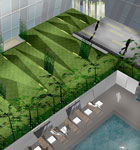CITYCENTER DC
location
Washington, DC
size
10 acres
completion
2013 (estimated)
developer
Hines/Archstone
lead architect
Foster + Partners
masterplan and lead landscape architect
Gustafson Guthrie Nichol
associate masterplan architect
Shalom Baranes
landscape architect
Lee & Associates
The creation of CityCenterDC began seven years ago. At its completion, it will consist of six very different above-grade structures united by one theme—sustainability. The pedestrian-oriented mixed-use neighborhood is a collaboration among Shalom Baranes, Foster+Partners, Hines/Archstone, Gustafson Guthrie Nichol, and Lee and Associates, the latter two companies serving respectively as the master-planner and lead landscape architect and the provider of comprehensive landscape architectural services. “It was important to be environmentally responsible, but at the most basic level green design is about being smart and efficient in how you use resources,” says Rodrigo Abela, a principal at Gustafson Guthrie Nichol. “The mixed-use aspect of the CityCenterDC means it’s one of the city’s most efficient communities, and for many, it’s a dream place to live and work.”
site/
Once home to the old Washington, DC, Convention Center, the site for CityCenterDC is publicly owned, and though the city worked closely with the developer as well as Lee and Associates and Gustafson Guthrie Nichol to ensure that the project would be environmentally sustainable, the city was also certain that the project’s direct purpose needed to be furthering community interests. “The full site is a 10-acre parking lot, five blocks from the White House,” says Abela, who worked on the landscape master-plan for the project. “A void of this scale right in the middle of downtown has been extremely detrimental to the surrounding neighborhoods; it’s been acting as a barrier and interrupts the natural extension of street life. The challenge has been creating the right scale of buildings and [the right] proportion of built space to open space that will result in the sort of vibrant environment we are searching for.”
green roofs/
When designing the landscape for the project’s four residential buildings, which include two rental buildings and two condominium buildings, Gustafson Guthrie Nichol, in collaboration with the project architects, made the decision to face the rental units’ terraces to the interior of the block to help bring light to the pedestrian alleys. The interior positioning also provides additional quiet and privacy. “And for those residents who want a little social activity, there is full access to both of the rental buildings’ common areas, which include the green roofs,” says Jeff Lee, president of Lee and Associates. In the rental buildings more than 55 percent of the roof area will be vegetated, and it will have the ability to retain more than 8,000 cubic feet of storm water, meeting the city’s and LEED’s requirements for storm-water treatment and retention. Overall, the two rental buildings cover 1.6 acres and include amenities such as a pool, a bocce court, paved terraces, outdoor grills, and planted gardens.

Plantings in the residential courtyards include paved terraces perfect for group gatherings.
landscape/
“The careful placement of streetscape plantings and furnishings were essential in making [CityCenterDC] a well-functioning public space,” Lee says. All together, the benches, bike racks, and dense tree coverage help to create an environment that is both inviting and lively and provides a shaded, pedestrian space. Due to the area’s heavy traffic, thorough coordination was required to create the lush landscapes, and utility and infrastructure demands required communication among the entire project team. “In the residential courtyards, where there is deep shade, we created a moss garden on a series of faceted mounds,” Lee says. “One dark- and one light-colored species are used to accentuate the mounds and the horizontal area.”

Moss mounds and green screens in residential courtyards offer a sense of privacy while creating optimal microclimate conditions.
plant materials/
“The plants that were chosen for the landscape are native or adaptive and are uniquely suited to the microclimate conditions,” Lee says. “Swamp white oak and Chinese elm trees are used together with inkberry holly and saltmeadow cordgrass as ground cover.” Lee also decided to mix multistem trees such as star magnolia, amur maple, and serviceberry with witch hazel, oakleaf hydrangea, and fothergilla to provide yearlong interest in the landscaped areas. Climbing hydrangea, clematis, and trumpet vine will also be planted on metal screens to provide more privacy and a greener setting.

One low-impact-development strategy is to collect storm water in planting areas, filter it through bioretention plants and soil, and slowly release it into the city’s storm-water system.
construction materials/
Abela knew he wanted the project to respond to the natural characteristics of the area. Each material was considered for its ease of assembly, location, and balance of colors. “Our material selections are all guided by a continued exploration into understanding how people experience space and how we can shape that experience,” Abela says. “The outdoor spaces have a much more limited palette than indoor spaces because they have to withstand the elements. For the exterior, we worked with stone, wood, concrete, and metal. Many of those same material choices are also echoed throughout the interior.”

Curb cuts direct street runoff into the planting areas, where a continuous soil trench below ground acts as an extended biorentention and root-growing zone.
water management/
One of the most successful results from the collaboration between Lee and Associates and Gustafson Guthrie Nichol is the CityCenterDC streetscape design, which includes a low-impact-development (LID) system for managing storm water, which helps reduce the spread of polluted runoff. “In the streetscape, bioretention areas collect roadway and public sidewalk runoff and provide qualitative and quantitative treatment,” Lee says. “Curb cuts direct runoff from the streets into the tree-planting areas while a continuous soil trench below a supported sidewalk provides an extended bioretention and root-growing zone.” The storm-water-management system will help the project gain its LEED certification as well as assist in making the site a LEED-ND Gold-certified community.

